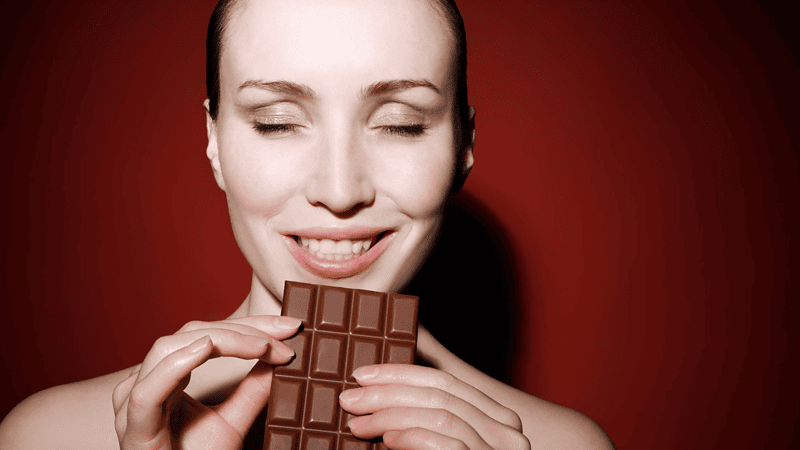How yoga can help us resist cravings. By Charlotte Watts
One of the many reasons that the physical practice of yoga has become so popular in the West is that its health benefits are not simply about the toning and strength it brings, but because it affects the way we can meet life off the mat. The level of focus it asks of us and learning to find softness within strong sensations, trains our minds and bodies to deal with similar intensity in whatever form.
Cravings for foods we’d rather not eat, things we know we don’t need to buy and relationships we know we’d be better off without coming with oodles of thoughts, feelings, thoughts about feelings, feelings about thoughts and a whole gamut of very real physical responses. We know that knot in the stomach, tightness in the chest, clamping in the head would all just go away if we filled that want with the thing we’re drawn to. But we also know that we’re going round and round with those patterns, so how do we get off the merry-go-round?
Getting connected
So much of a yoga practice – whether posture work (asanas) or more still, meditative aspects – is placing ourselves into positions or with the focus that creates the challenge of resistance. Any reason we start a yoga practice is valid, but ultimately people continue because they start to feel more connected to their body and learn to be with the whole mixed bag of feelings churned out by our brains. The physical challenge, opening up your body in new ways, not being able to run away from that pose you don’t like, having to simply be still for any period of time; all of it can really push our buttons in places we might not like them being pushed.
Learning to stay with that, explore these sensations and yes, even switch off the judgemental “I like this”/ “I don’t like this” mind can change our perception and lessen the level of reactivity to change and barriers. That’s where the new relationship with craving sensations off the mat can really start to flourish and we can feel we have more choice when they arise.
How a physical yoga practice can help with cravings
Different aspects of yoga practice are known to help us address giving into wants in the following ways:
Restorative yoga
In this practice, our bodies are placed in positions where they are fully supported and don’t need to exert any effort to stay. Props like bolsters, blankets and blocks are used to ‘bring the floor to you’, so that you feel completely held and you can simply be in the position, stepping away from any sense of doing.
A recent study showed this form of yoga helped with weight loss through its alleviating of stress hormones. Letting the body come to complete and supported rest tells our whole system that it is safe. So many of our urges and knee-jerk responses come from a state of ‘constant alert’ that doesn’t allow us to settle into an easy rhythm. The continually stimulating input from technology, news, the need ‘to do’ and worries from inside us can give the signals that there is danger around.
Learning how to be still, soft, non-reactive and trusting can make all the difference. This is not easy though, taking the intensity and focus to stay in poses, means we have to be more consistently focused on each breath and the unfolding of the feelings from our body in each moment.
Forward bends
The attitude we cultivate folding forward into ourselves is one of yielding and surrender, the absolute opposite of craving and wanting. Often when we start practicing the physical form of yoga, forward bends can create that very same spike of desire – we just want to get further. When we practice the fine art of letting go, we can notice that our body softens and we can deepen more easily. Yoga helps us to experience strong sensations in life by allowing us to look at them in the postures; long-term practitioners have shown to put on less weight over 10 years because they were good at resisting cravings.
Forward bends also help regulate appetite and want if you practice those where the legs are straight, lengthening the hamstrings and creating good vagal tone; this helps our ability to self-soothe when things get over stimulating. Bend your knees whenever you need though; straining the lower back is never helpful.
Backbends
Backbends lengthen the front of the body and contract the back, the opposite motion too much modern postural habits where we hunch over desks and computers. Even simply arching from the bottom of your ribs up through a long neck, to open your chest, can create an opening in the heart and breath that can make us feel we have the energy and strength to resist cravings.
Backbends that are done as part of a well-sequenced class, allowing build-up and releasing down of the muscle groups involved, can ultimately help strengthen our lower backs and encourage better postural habits whilst moving and sitting in life. This helps our whole bodies respond to stress with more resilience, strengthening our abilities to stand tall and walk away gracefully from that tempting cake.
Three poses to help when cravings strike:
Setu Bandha Sarvangasana – Bridge Pose
This pose is a clever backbend that helps position the neck and shoulders to release, areas where we can keenly feel the effects of stress and feel locked into our responses. It can feel rather intense when we come from a place of tension, so watch you don’t grip the breath and fully release into the sensations. The strength needed to sustain the pose can help redirect attention from cravings, but also show us how we need to keep soft in the breath, eyes and jaw to be able to be with those strong sensations and not introduce more stress. Breathing up on the inhalation and down on the exhalation can produce a wave-like motion through the spine and take up focus we may be giving to cravings.
Viparita Karani – Waterfall Practice aka ‘Legs Up The Wall’
This restorative backbend works best when we raise the hips above the heart, creating a supported backbend with full chest opening and opening at the base of the skull that creates self-soothing through the calming vagus nerve. As you lie and allow the blood to flow back easily to head and heart, this pose can help release the excitatory state that craving produces.
Balasana – Child Pose
Child pose is the ultimate resting forward bend to come back to anytime and catch up with your breath and curl into the safety of a foetal position, where the ‘unsafe’ signals of stress that prompt cravings can be soothed. The brain is calmed from tipping the head forward and naturally energised from gentle pressure on the forehead. This means that balasana can be used as a nourishing rest-stop between poses for anywhere from 10 seconds to a minute or as a restorative pose in its own right at the relaxing end portion of a practice.
Charlotte Watts is a UK-based yoga instructor and the author of The De-Stress Effect: Rebalance Your Body’s Systems for Vibrant Health and Happiness (charlottewattshealth.com)







